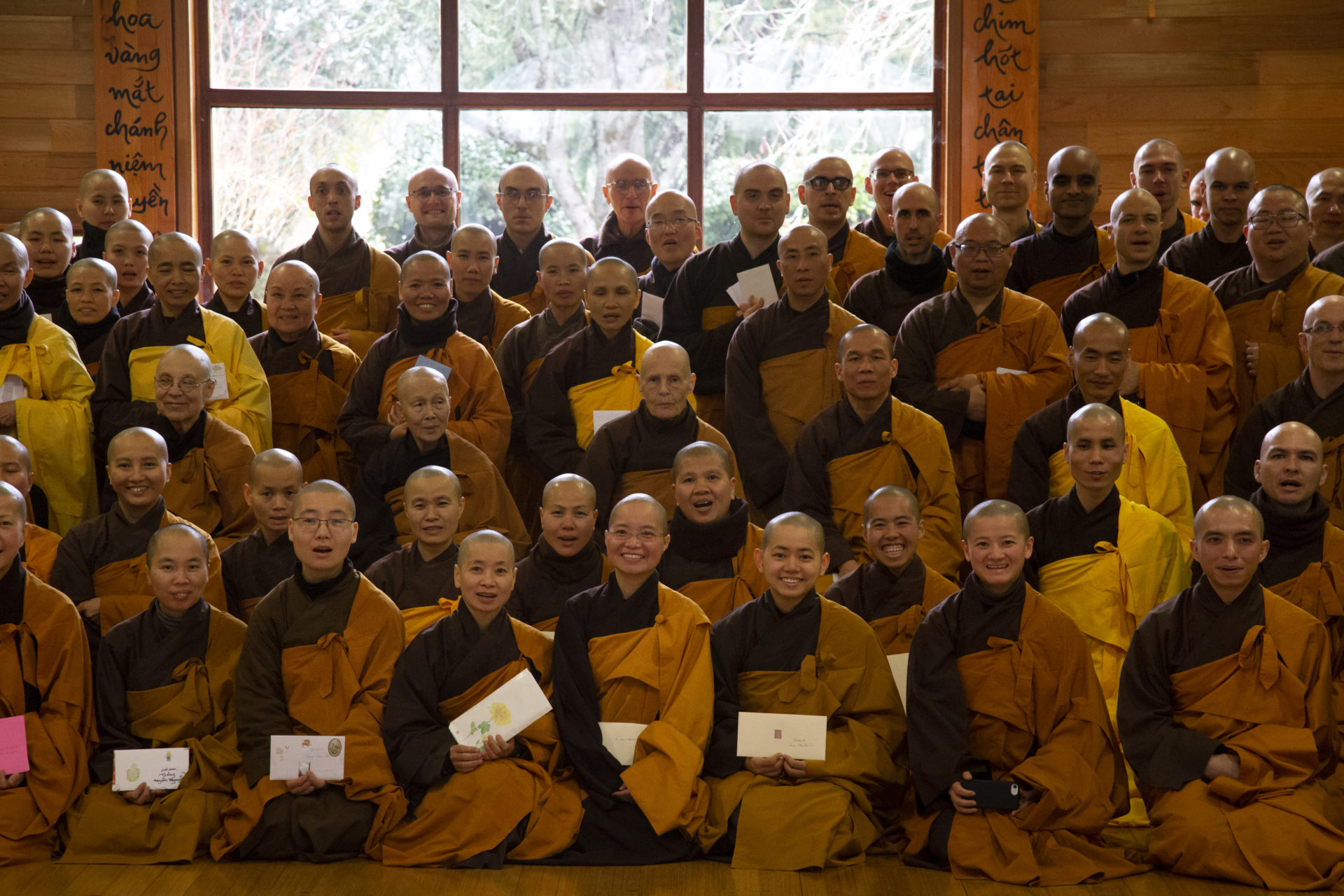How to Build a Spiritual Altar for Your Sacred Space
The post How to Build a Spiritual Altar for Your Sacred Space appeared first on The Yoga Nomads.
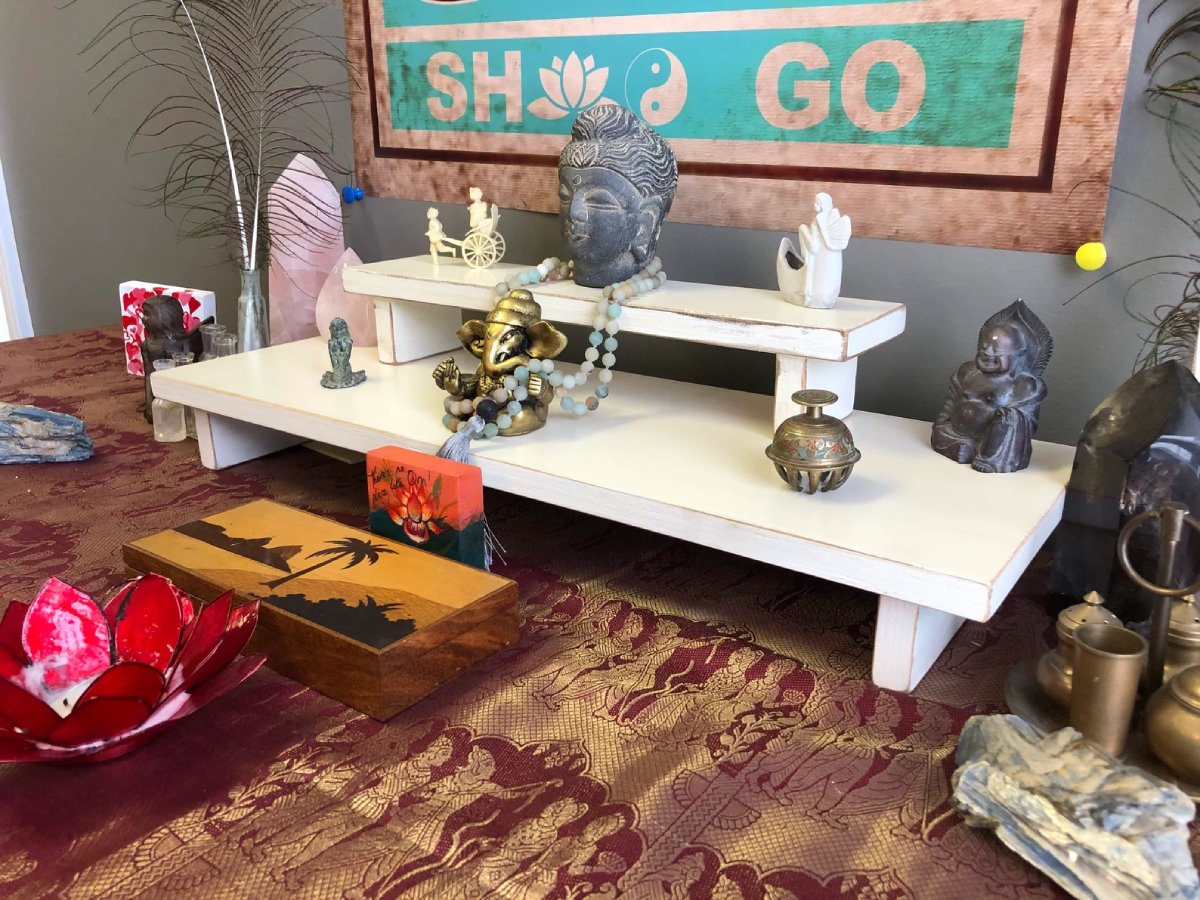
If you’ve been craving a sacred space to unwind, meditate, and focus on your spiritual intentions, an altar is the perfect addition to your home or yoga studio.
For thousands of years, different spiritual displays have been created on tables, in temples, and in nature. Historically, these were places for specific rituals like making offerings to gods or reciting specific prayers.
Greeks and Romans dug pit altars to receive offerings from deities of the underworld. Catholics placed an altar table in the center of the church for mass and communion. In the Vedic religion, practitioners built elevated outdoor enclosures lined with grass and even incorporated an area for sacrificial fires.
In the modern day, altars can be completely secular ways to engage with your personal development or spirituality. Whether you’re seeking a meditation altar, a place to keep sacred texts, or a simple daily reminder of things you love, an altar is the perfect place to reflect on yourself or your connection with a higher power.
Here is everything you need to know about how to build an altar, what to put on it, and how to use it in your unique daily practice.
What is a Spiritual Altar?
The word altar comes from the Latin term altare, which means “high”, as well as the Latin verb adolere, which means “to ritually burn or sacrifice”. An altar is a special space where you can spend time on your spiritual practice.
Altars are often used for self care, prayer, a daily ritual, meditation, yoga, or manifestation. They can include everything from candles to crystals to photos to books, and beyond.
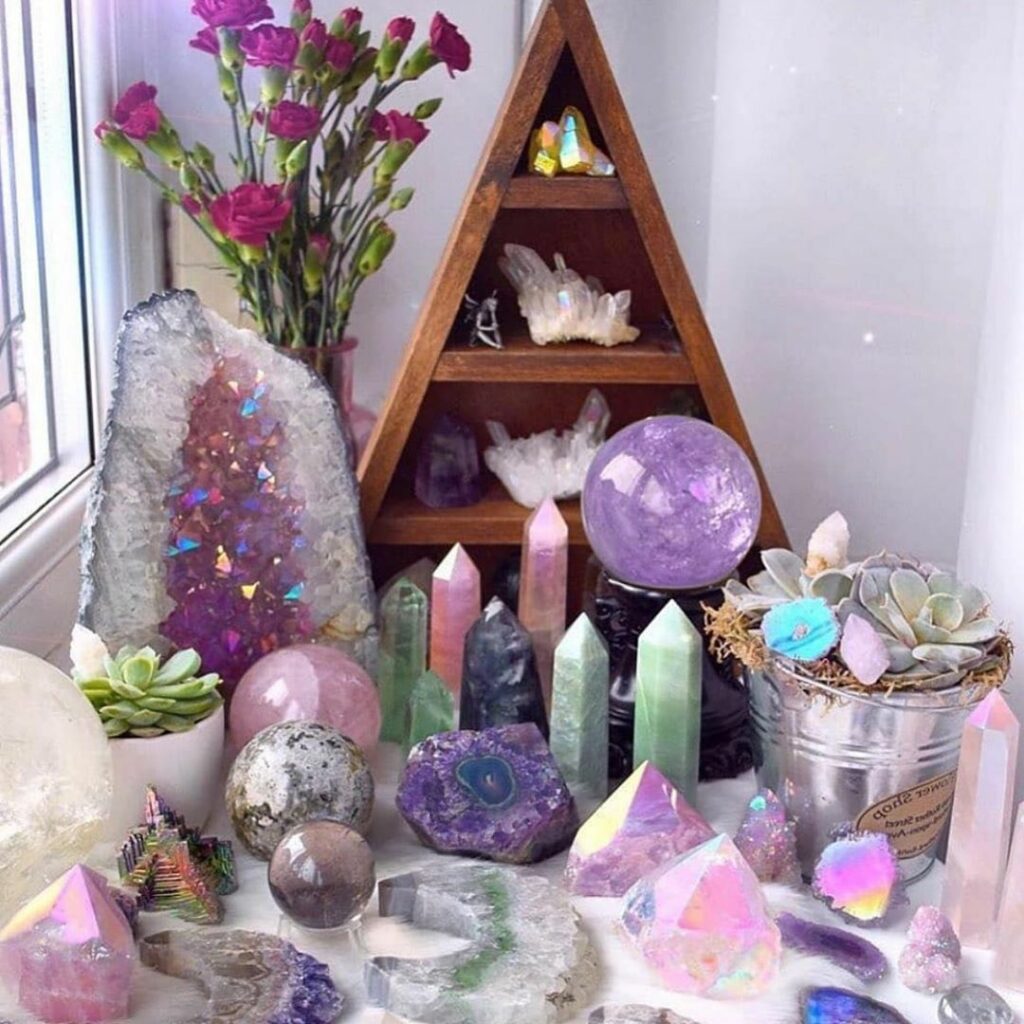
The most important part of an altar is the intention behind it. It should be strategically placed and designed specifically to help you feel more aligned with your own personal growth journey. The elements used in your altar can represent your connection to your spirituality or the divine.
You don’t have to be super woo-woo, religious, or even spiritual to use an altar. In fact, an altar could be a completely secular fireplace mantle, a writing desk, or a focal point of a room with family photos.
An altar can even be as simple as a quiet area in your garden where you place crystals, stones, flowers, and trinkets on the earth.
Regardless of its location or decoration, a spiritual altar should feel calming, grounding, and inspiring. It is a place you go to quiet your mind and escape from the chaos of the outer world.
What are Altars Used for?
Altars have historically been used for everything from holiday rituals to religious practices to honoring the dead.
Christian altars are most commonly a place for breaking bread and honoring Communion, whereas Pagan altars were used for spell casting.
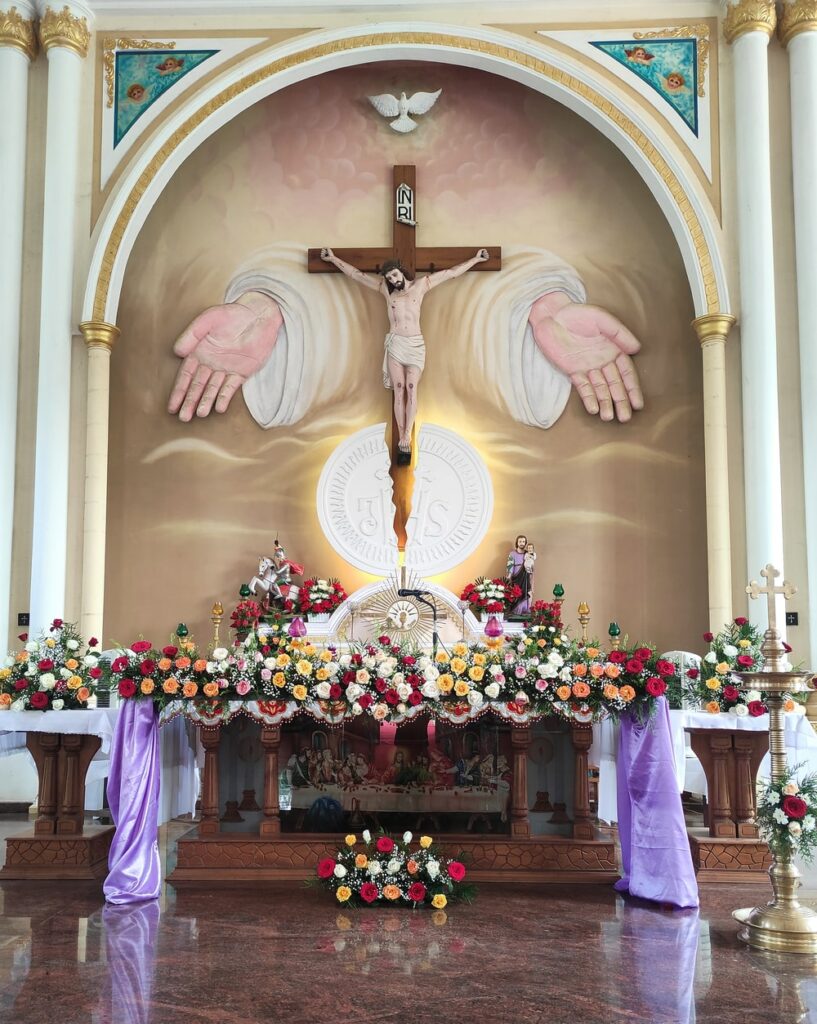
Hindu altars are the primary place for daily worship, and they can be found in temples as well as homes. Similarly, Buddhist altars are a place for daily prayer. They can also include tablets and memories of dead ancestors.

As you can see, an altar can have a vast variety of uses and meanings for different people. Ultimately, they all share some form of spiritual energy that can be catered to specific beliefs and preferences.
On a daily basis, altars are a place where you can simply honor silence for 5-10 minutes at the end of the day. It could also be a safe space where you can write, paint, meditate, or do yoga.
7 Steps to Designing a Personal Altar for Your Spiritual Practice
There are no steadfast “rules” for creating an altar. This process is a deeply spiritual and personal. It should be catered to your specific spiritual practice, religious beliefs, or personal development journey. That being said, there are a few stepping stones that can guide you on the right path toward building your own altar.
Here are 7 simple steps to designing your altar space, plus ideas and inspiration:
Intention setting: What is your altar’s purpose?Intention is the driving force behind achieving spiritual growth. Just like setting an intention before a yoga practice or manifestation session, a conscious objective for your altar helps guide your journey toward a desired result.
You can set your intention internally or write it down for more clarity, for example:
I am creating an altar that will act as a reminder for my daily 10 minute meditation practice.This altar is where I will journal about my gratitude and manifestations every morning.This altar is a safe space for me to exercise my creativity.This altar is where I will honor my ancestors, spiritual mentor, or monumental people in my life.I am building an altar to deepen my connection with God or the Universe.I am crafting a space where I can find more self love.Use this guiding motive to help you decide where your altar will be most useful and what elements will be most beneficial to guide you on your desired path.
Choose a space: Where should you place an altar in your house?The physical space where an altar is placed should feel- above all else- peaceful. Ideally, it is a quiet area of your home where you can go to be in solitude. It can also be outdoors if you prefer a more natural setting.
It said that altars can be oriented in a specific cardinal direction for certain beliefs. For example, Christian traditions face altars toward the eastern side of a room, or toward the rising sun. Some spiritual beliefs orient their altars westward toward the setting sun. Someone who has an altar with living plants or a specific affinity for light may want to face their altar southward for the most sunshine in their home.
If your altar is for a more communal or familial use, you may wish to put it on your fireplace mantle or in the kitchen for everyone to access. However, if you want a place to escape the outer world, you may wish for your altar to be in a spare room, yoga room, or even a closet that is hidden from outside energies.
Here are 10+ Meditation Room Ideas On a Budget for a Sacred Space Getaway in Your Own Home.
Decide a base: What will your altar be built of?Given its ancient Latin translation, an altar should technically be elevated off the ground. You can use a shelf, nightstand, side table, mantle, or windowsill to get started.
Here are the 7 Best Meditation Tables, Altars, and Accessories we’ve found online.

We also love the idea of hanging a shelf specifically for use as a small altar when you don’t have much floor space. This moon phase triangle shelf even includes hooks for dream catchers or other decor.
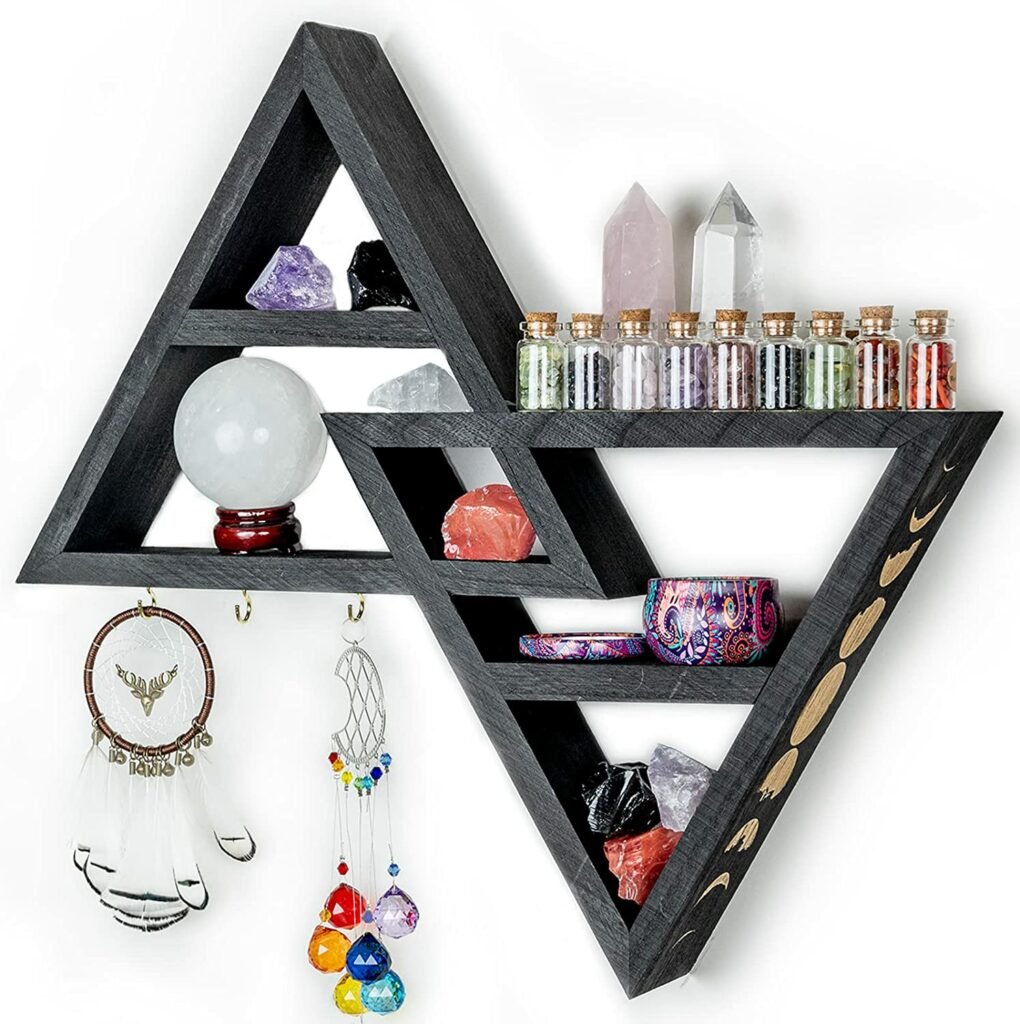
There are also gorgeous altars that can be created in the soil of your garden…
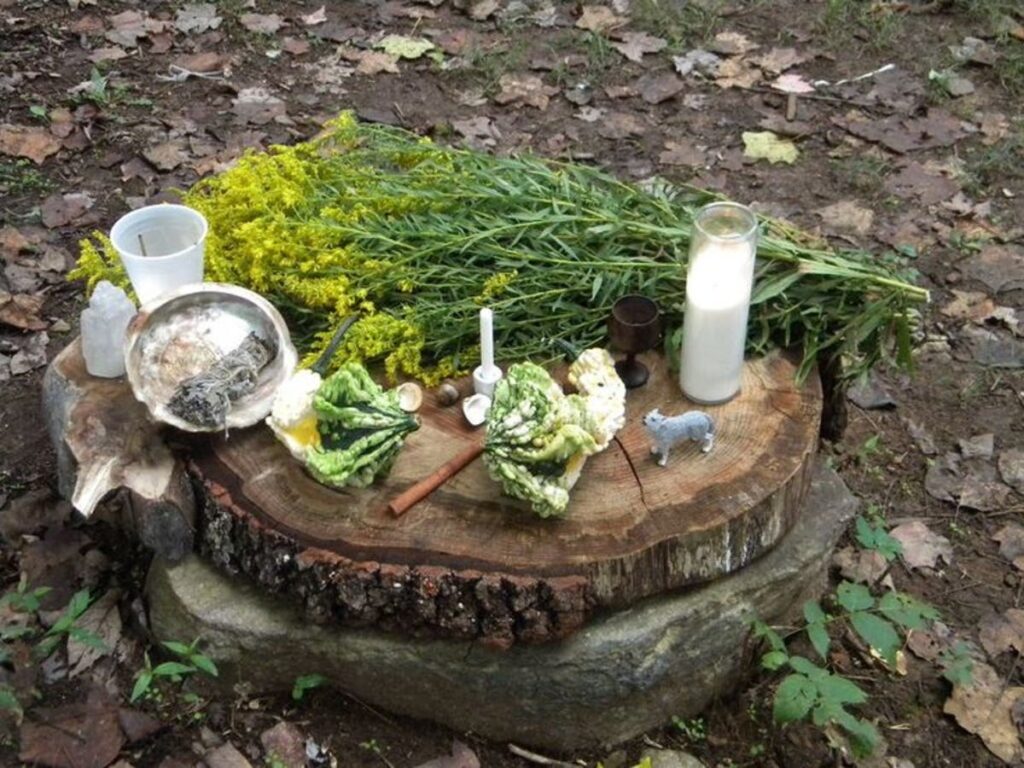
For the cheapest option, buy a small table or bench from a local thrift store and cover it with a tapestry or altar cloth like this Moon Phase Altar Cloth:
 Fill your altar: Gather sacred objects for spiritual rituals
Fill your altar: Gather sacred objects for spiritual ritualsAn altar can be filled with anything your heart desires! Once you have set an intention, found a space, and decided on a base, you’re ready to gather objects that mean the most to you. This is where you can get especially creative and even sentimental.
Some of the most common elements used on spiritual altars include:
Crystals: Here are our favorite healing crystals for protection as well as the best chakra crystals for aligning your energy centers.A natural raw amethyst crystal geode cluster is a dazzling addition to any altar. This stone represents serenity, purification, trust, and grace.
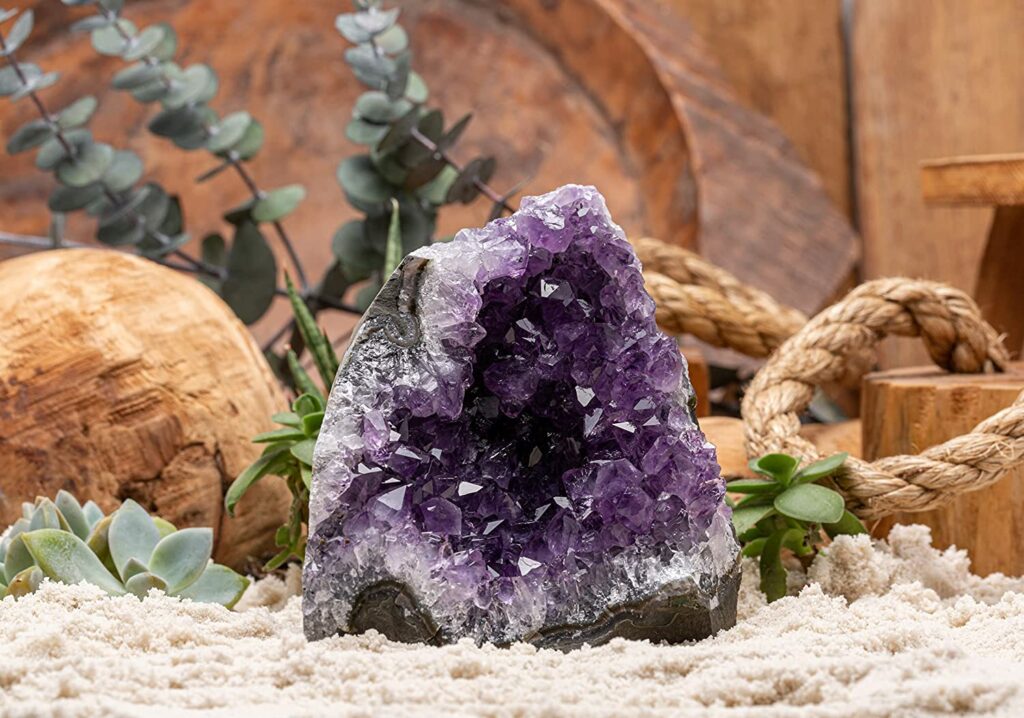 Images: Frame or display photos of ancestors, a specific deity, spiritual guides, inspirational role models, or important people in your life.Divination Tools: Tarot cards, oracle cards, or crystal balls are commonly used to look into the past and future.
Images: Frame or display photos of ancestors, a specific deity, spiritual guides, inspirational role models, or important people in your life.Divination Tools: Tarot cards, oracle cards, or crystal balls are commonly used to look into the past and future.This deck of Moonology Oracle Cards is great for syncing your manifestations with the new moon and full moon cycles.
 Aromas: Essential oils, diffusers, incense, scented candles, palo santo, and sage infuse your sacred space with a smell that can help put your mind into relaxation mode.
Aromas: Essential oils, diffusers, incense, scented candles, palo santo, and sage infuse your sacred space with a smell that can help put your mind into relaxation mode.Burning incense is especially useful for bringing spiritual energy into your practice. We love this all-natural, toxin-free incense from Juniper Ridge.
 Sacred earth elements: Fresh flowers, dried flowers, herbs, rocks and stones, sweet grass, feathers, and other things found in nature help connect you back to the source of life.Light: Candles, Himalayan salt lamps, lamps, or other sources of light can help you set the mood on a meditation altar.
Sacred earth elements: Fresh flowers, dried flowers, herbs, rocks and stones, sweet grass, feathers, and other things found in nature help connect you back to the source of life.Light: Candles, Himalayan salt lamps, lamps, or other sources of light can help you set the mood on a meditation altar.We love this Himalayan Salt lamp that purifies the air and brings a soothing vibe to the space.
 Meditation Tools: Mala beads, mantra books, fire gazing candles, a meditation chair, yoga mat, or singing bowls.
Meditation Tools: Mala beads, mantra books, fire gazing candles, a meditation chair, yoga mat, or singing bowls.We love this Frosted Quartz crystal Singing Bowl for displaying on an altar and using in sound healing practices.
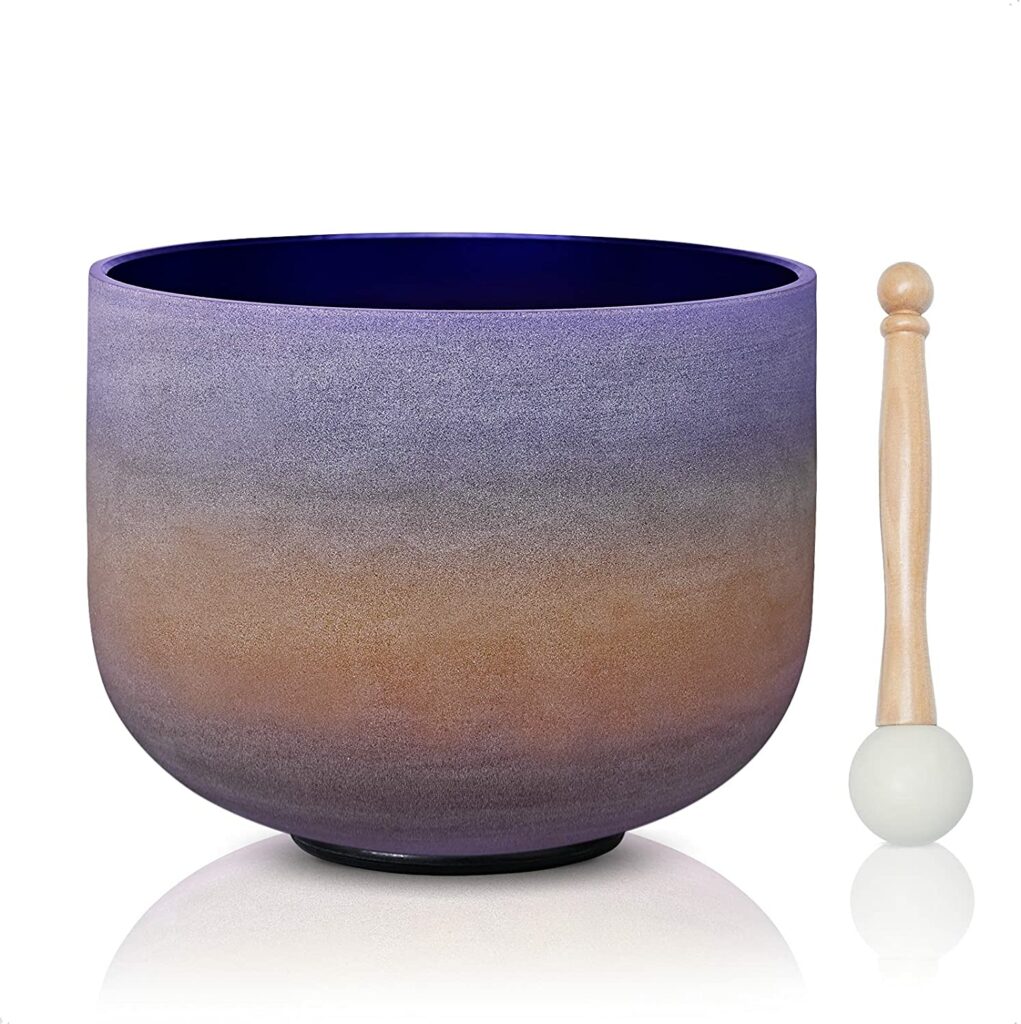 Tools for Self Care: Depending on your specific goals and self care practices, you may want to add a gratitude journal, notebook, Gua sha massage stone, or sacred oils to your altar.Other Objects for Your Belief System: Rosary beads, sacred texts, books, mantras, images of gods or deities, and religious ritual tools.
Tools for Self Care: Depending on your specific goals and self care practices, you may want to add a gratitude journal, notebook, Gua sha massage stone, or sacred oils to your altar.Other Objects for Your Belief System: Rosary beads, sacred texts, books, mantras, images of gods or deities, and religious ritual tools.If you really don’t know where to start, this Energy Mindfulness Starter Kit is the perfect tiny altar that comes complete with a foldable bamboo table top, crystals, smudge spray, candles, and more.
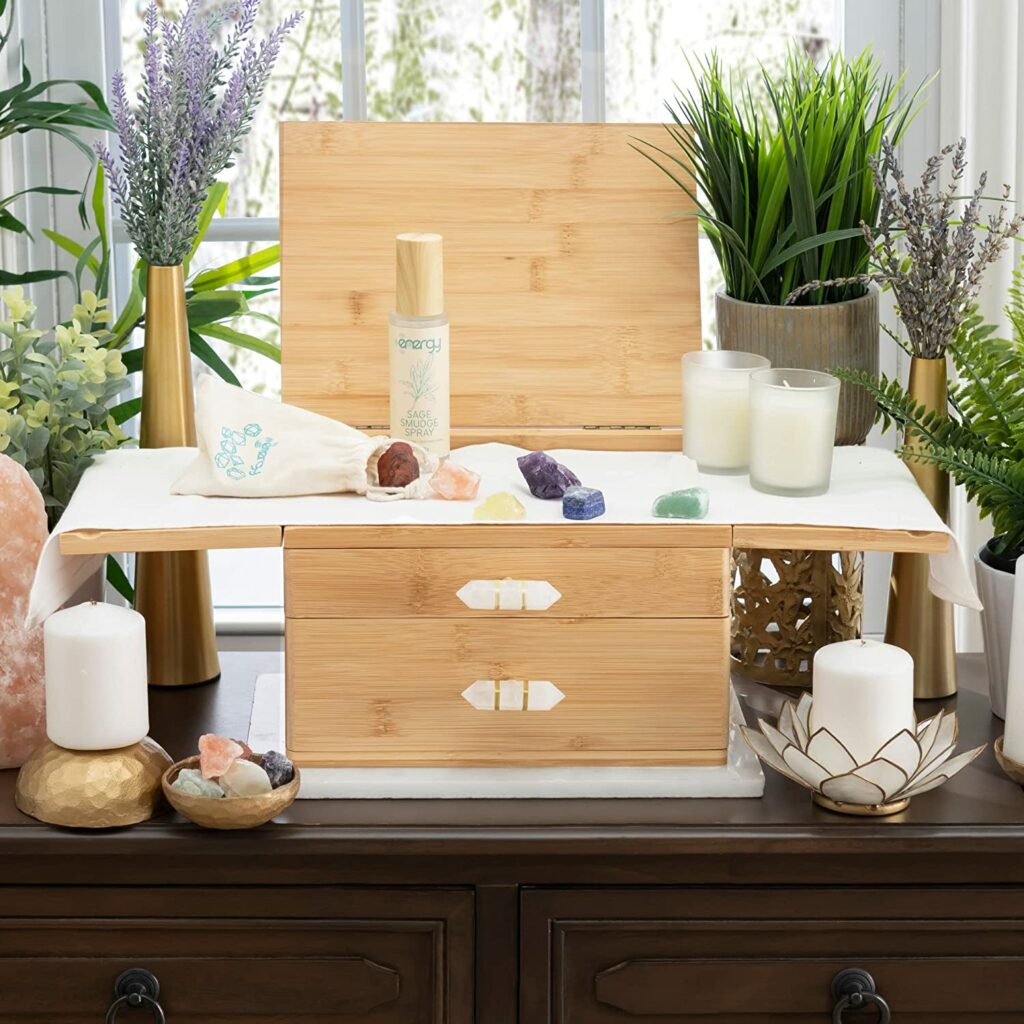 Arrange your altar: Place objects based on your goals
Arrange your altar: Place objects based on your goalsArranging elements on your altar is pretty simple. Again, you’ll want to refer back to your intention and your spiritual practice or organized religion.
Begin by deciding the focal point of the altar. In this one, it is a Ganesh state and an offering bowl:

The designer of this altar uses a daily oracle card as the focal point and then arrange crystals and accessories around it:

Next, you’ll want to place your larger elements like geodes, candles, flower vases, and statues. It’s best to keep tall objects in the back like this:
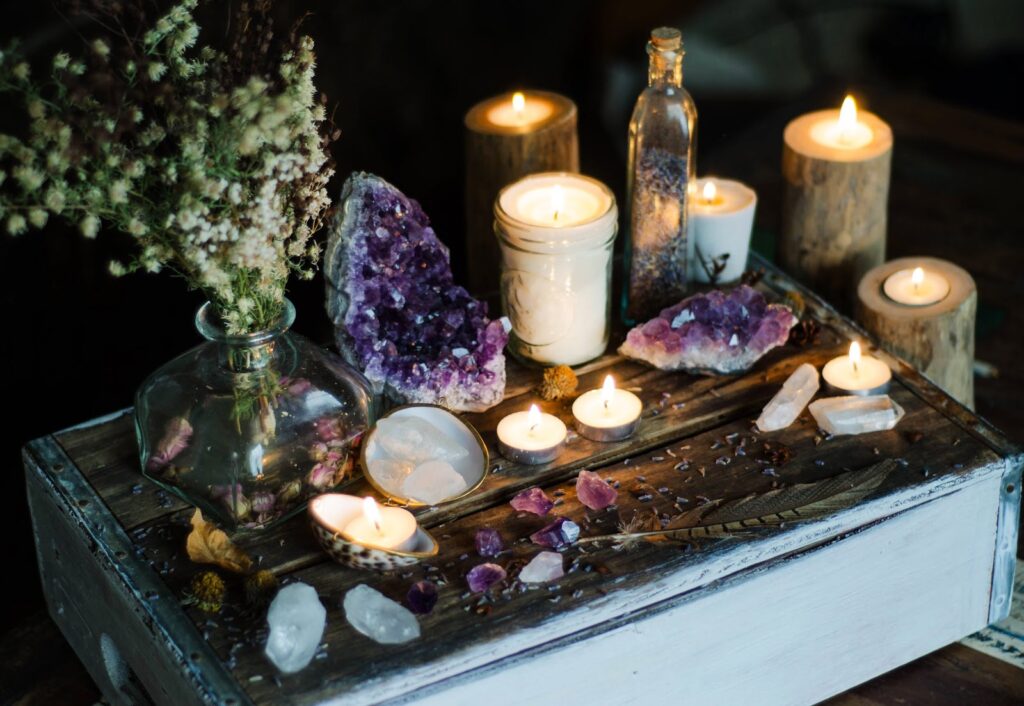
Then, begin placing your small elements like crystals, feathers, and accessories:
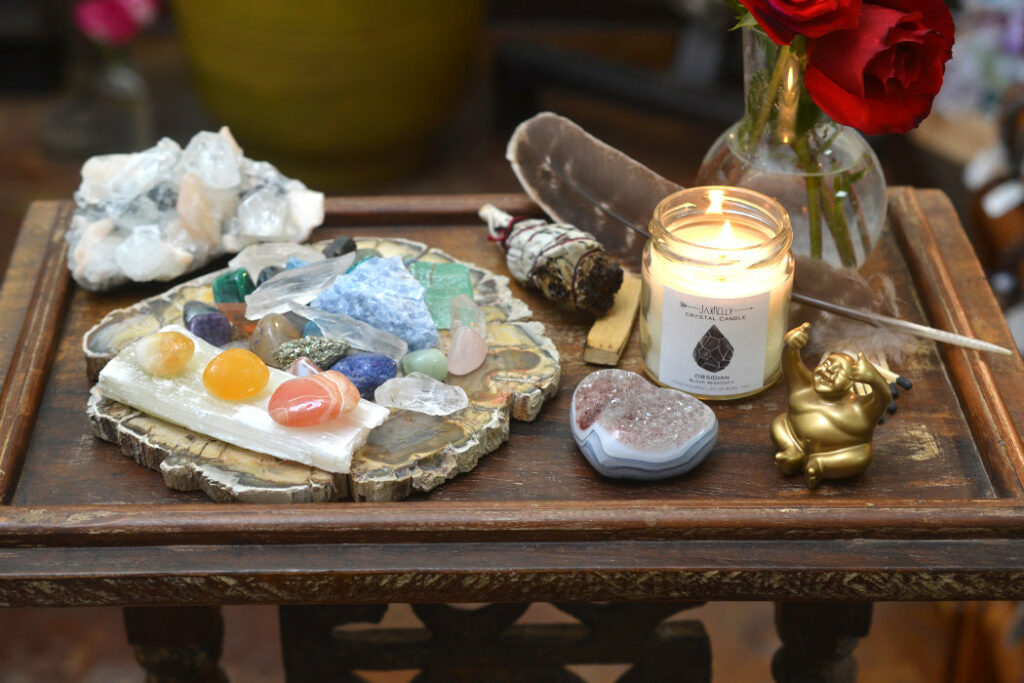
Last but not least, you’ll want to ensure that your altar is visually appealing to you. It can be changed around at any time depending on your life stage and self care practices.
 Positive energy: Meditate with your altar and use it in spiritual practices
Positive energy: Meditate with your altar and use it in spiritual practicesInfusing your altar with positive energy is very important, especially if you source items or crystals from unknown spaces. Every object on Earth carries a specific vibrational energy that may need to be realigned with your purpose.
This is a process that is difficult to instruct. It requires going into your own heart with prayer or meditation, then reflecting on the deeper purpose and symbolism of the altar you’ve created. What ritual do you want to form around this sacred space? What does the altar represent in the scheme of your life? What type of spirit or energy do you wish to have when you leave the altar?
Many yogis have found that they can come to their altar after a really stressful or chaotic day and leave feeling completely renewed. Writers and creatives find that they can sit at their altar when they’re feeling blocked, then leave with renewed inspiration. Families or couples may even gather at a meditation altar after a conflict to help remind each other of their mutual respect and love in spite of misunderstandings.
Cleaning and clearing: Maintain your altar’s energyLastly, it is vital that you keep your altar both physically and spiritually clean. Physically, this may mean dusting, wiping down, or otherwise cleaning the objects on a regular basis. This is a sign of respect for any higher powers or spiritual guides that you may be seeking to connect with.
Spiritual cleansing may involve sage smudging or palo santo to clear the energy of the space before and/or after use. You can also use the fire of a candle or the power of mantra chanting to cleanse the space of any negative energy that may have inadvertently been introduced. Some prefer to do this on a regular basis, while others prefer to clear the altar in sync with the new moon as a sign of new beginnings.
Key Takeaways: A Sacred Altar is Where You Connect with the Divine
An altar is a place to reflect on your life, your goals, and your spirit. This can be a huge step in your journey toward more inner peace and happiness. Regardless of external circumstances, you can return to your altar for a sense of calm and groundedness.
Ultimately, no altar is the same (and they shouldn’t be!) Use your internal guide to create an altar that feels safe and motivational for you personally. There are no rules, and most importantly, there are no limits to the sacred connection you can build with your new altar space.
The divine in me honors the divine in you,
Namaste!

 AbJimroe
AbJimroe 











